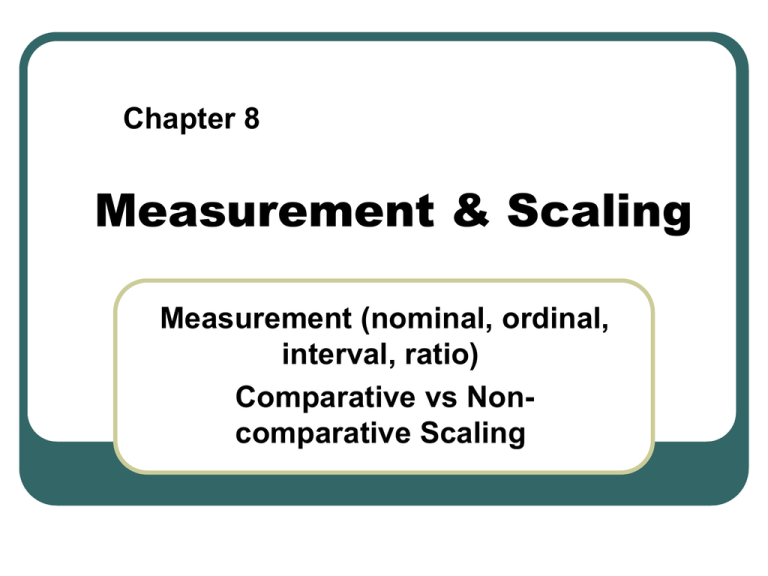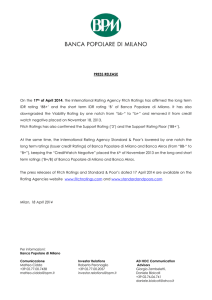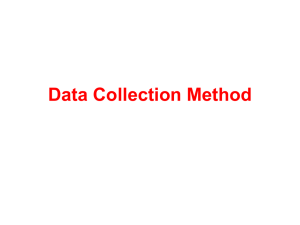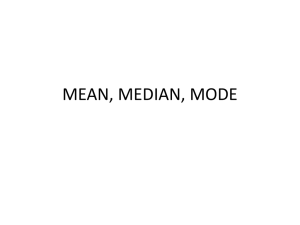data interval
advertisement

Chapter 8 Measurement & Scaling Measurement (nominal, ordinal, interval, ratio) Comparative vs Noncomparative Scaling Measurement: definisi, apa yang di ukur ? Penentuan indeks, verifikasi terhadap tinggi, berat, ciri fisik lainnya adalah pengukuran. Seberapa bagus sebuah lagu, lukisan, kepribadian seseorang, merupakan pengukuran. Mengukur: menemukan batas-batas, dimensidimensi, kuantitas, atau kapasitas sesuatu, dgn membandingkan dgn sebuah standar. Measurement : definisi, apa yang di ukur ? Pengukuran: pemberian angka atas kejadian, obyek, atau aktivitas empiris yg memenuhi kaidah-kaidah yg berlaku. Ada 3 proses pengukuran : 1) Menseleksi kejadian-kejadian empiris yg dapat diamati (observable) 2) Mengembangkan serangkaian mapping rules: pemberian angka atau simbol untuk mewakili aspek-aspek dari kejadian yg sedang diukur. 3) Menerapkan mapping rules pada setiap pengamatan kejadian itu Pengukuran (measurement) Pengukuran: pemakaian satuan kuantitatif/ kualitatif pada objek (subjek) penelitian; yg mendeskripsikan jumlah atau tingkat properti yang dimiliki objek tersebut. Satuan yang dipakai harus generally accepted. Misal: berat badan satuan yang diterima umum adalah kg, bukan gram, walaupun samasama menyatakan berat. 4 Jenis Data Berdasarkan Skala Ukurnya 1. NOMINAL: membedakan obyek, misal jenis kelamin (1=pria, 2=wanita). 2. ORDINAL: membedakan obyek dan menyatakan urutan menurut besar kecil, misal pendidikan (1=SD, 2=SLTP, 3=SMU, 4=PT). 3. INTERVAL: membedakan obyek, menyatakan urutan menurut besar kecil, dan adanya interval yang sama, misal nilai ujian. 4. RATIO: membedakan obyek, menyatakan urutan menurut besar kecil, adanya interval yang sama, dan adanya NOL mutlak, misal berat suatu produk. 5 Jenis Data Berdasarkan Skala Ukur Sifat Jenis Data Membeda kan Ada Ada Ada Urutan/ titik nol Interval mutlak Tingkatan Nominal Ordinal Interval Rasio 6 Data Nominal Contoh: gender, ID number, marital status, pekerjaan Hanya melakukan kategorisasi variabel yang diukur. Satu objek penelitian hanya masuk pada satu kategori. Angka hanya label. Pemberian skor hanya sekedar untuk membedakan (jadi dapat dibolak-balik) Tidak memiliki jarak. Tidak mengandung nilai yang menunjukkan rangking/urutan. Aplikasi statistik yang diperbolehkan hanya modus dan distribusi frekuensi. 7 Data Nominal Contoh: Pengukuran “Pekerjaan Responden” Jenis Pekerjaan Pegawai Wirausaha Pelajar/Mahasiswa Pengukuran (pemberian skor) yang mungkin 1 2 3 3 2 1 2 1 3 8 Data Ordinal Melakukan kategorisasi variabel Kategori yang ada dapat diurutkan (order) Berlaku formula: bila a > b, b > c, maka a > c. Hanya ada urutan, tapi jarak (interval) antar kategori tidak sama. Misal: “sangat puas” lebih baik dibandingkan “puas”, dan “tidak puas” juga lebih baik dibandingkan “sangat tidak puas”; namun jarak “sangat puas” dengan “puas” ≠ jarak antara “tidak puas” dengan “sangat tidak puas”. Aplikasi statistik yang diperbolehkan (berlaku) modus, distribusi frekwensi, dan median. 9 Data Ordinal -- contoh Below are the attributes used by many customers to select a restaurant. Give ranking for each attribute from 1 for the attribute you consider as the most important, to 7 for the attributes you consider as the least important, when you select a restaurant. Price Service speed Location Consistency of food quality Food variation Staff friendliness Portion size ……….. ……….. ……….. ……….. ……….. ……….. ……….. 10 Data Ordinal -- contoh Pengukuran “Tingkat Pendidikan Responden” Tingkat Pendidikan SD dan sederajat SMP dan sederajat SMA dan sederajat S1 Pengukuran (skor) yang mungkin 4 3 2 1 1 2 3 4 11 Data Interval Memiliki sifat seperti data skala nominal & ordinal. Jarak satu kategori dengan kategori lainnya jelas. Misal IPK mhsw A=4 dan mhsw B=2, maka jarak IPK kedua mhs = 2. Namun data interval belum bisa dibandingkan secara mutlak (bukan berarti kepintaran A 2x B) Aplikasi statistik yang diperbolehkan modus, frekwensi, median, serta mean dan standar deviasi. 12 Data Interval -- contoh From the range 1 to 6 below, give rating on the latest fastfood restaurant you visited, where 1 for extremely unsatisfying to 6 for extremely satisfying: • • • • • • Price Staff friendliness Variation Service speed Food quality Portion size Extremely unsatisfying 1 2 1 2 1 2 1 2 1 2 1 2 3 3 3 3 3 3 4 4 4 4 4 4 Extremely satisfying 5 6 5 6 5 6 5 6 5 6 5 6 13 Data Rasio Example: height, weight, length, age, money, etc. Memiliki sifat seperti yg terdapat dalam data nominal, ordinal dan interval Plus…data dapat dibandingkan secara absolut; Misal: uang A $25, B $75, maka dapat langsung dibandingkan bahwa uang A adalah sepertiga dari uang B. • Plus…data rasio, angka NOL-nya mutlak (punya arti) 14 Perbandingan skala pengukuran utama Basic Common Characteristics Examples Nominal Numbers identify & Social Security classify objects nos., numbering of football players Ordinal Nos. indicate the Quality relative positions of rankings, objects but not the rankings of magnitude of teams in a differences between tournament them Temperature Interval Differences between objects can (Fahrenheit, be compared, zero Celsius) point is arbitrary Zero point is fixed, Length, weight Ratio ratios of scale values can be compared Scale Marketing Examples Brand nos., store types Permissible Statistics Descriptive Inferential Percentages, Chi-square, mode binomial test Preference rankings, market position, social class Percentile, median Attitudes, opinions, index . Range, mean, Product-moment standard correlation, t deviation tests, regression Age, sales, Geometric income, costs mean, harmonic mean Rank-order correlation, Friedman ANOVA Coefficient of variation Scaling Prosedur pemberian bilangan (atau simbolsimbol lain) pada suatu objek agar memberikan pengetahuan tentang ciri obyek yang diukur/ditanyakan. Secara berurut angka/bilangan diberikan untuk menunjukkan sesuatu pada objek. Scaling Contoh1: Sikap terhadap suatu universitas dapat diukur pada berbagai skala untuk menangkap indikator dari suatu variabel atau dimensi mengenai awareness, feeling, minat. Contoh2: untuk mengukur temperatur udara, ditunjukkan oleh variasi dari ekspansi/ kontraksi merkuri yang ada pada tabung merkuri. Memilih skala pengukuran Memilih dan mengembangkan skala pengukuran perlu mempertimbangkan berbagai faktor yang akan berpengaruh pada reliabilitas, validitas, dan kepraktisan sebuah skala. Faktor-faktor itu adalah : • Research Objective • Response types • Data Properties • Number of dimensions • Balanced or unbalanced • • • Forced or unforced choices Number of scale points Rater errors Skala Pengukuran Secara garis besar, skala pengukuran dibedakan jadi 2: 1. Comparative scaling. Pengukuran terhadap satu objek dilakukan dengan cara membandingkan langsung objek ybs dengan objek lainnya. 2. Non-comparative scaling. Satu objek diukur secara independen/bebas, tidak dibandingkan dengan objek yang lainnya. 19 A Classification of Scaling Techniques Scaling Techniques Non-comparative Scales Comparative Scales Paired Paired Comparison Comparison Rank Constant Order Sum Q-short Likert Continuous Itemized Rating Scales Rating Scales Semantic Differential Stapel 20 COMPARATIVE SCALING 1. 2. 3. 4. Paired Comparison Rank Order Comparison Constant Sum Q-Sort 21 1 Paired Comparison Scaling A respondent is presented with two objects and asked to select one according to some criterion. The data obtained are ordinal in nature. Paired comparison scaling is the most widely used comparative scaling technique. 22 1 Paired Comparison – Contoh… The most common method of taste testing is paired comparison. The consumer is asked to sample two different products and select the one with the most appealing taste. The test is done in private and a minimum of 1,000 responses is considered an adequate sample. A blind taste test for a soft drink, where imagery, self-perception and brand reputation are very important factors in the consumer’s purchasing decision, may not be a good indicator of performance in the marketplace. The introduction of New Coke illustrates this point. New Coke was heavily favored in blind paired comparison taste tests, but its introduction was less than successful, because image plays a major role in the purchase of Coke. A paired comparison taste test 23 2. Rank Order Scaling Respondents are presented with several objects simultaneously and asked to order or rank them according to some criterion. It is possible that the respondent may dislike the brand ranked 1 in an absolute sense. Furthermore, rank order scaling also results in ordinal data. Faster & easier than paired comparison scaling. 24 Preference for Toothpaste Brands Using Rank Order Scaling Form Brand Rank Order 1. Maxam _________ 2. Colgate _________ 3. Pepsodent _________ 4. Close-Up _________ 5. Ciptadent _________ 6. Sensodyne _________ 7. Ritadent _________ 8. Formula _________ 25 3. Constant Sum Scaling Responden diminta mengalokasikan sejumlah angka (misal 100) ke dalam beberapa atribut untuk merefleksikan tingkat kepentingan atribut tersebut. Total tingkat kepentingan dari semua atribut harus = sejumlah angka yang ditetapkan (sesuai contoh = 100). 26 3. Constant Sum Scaling Example: Mohon bagi angka 100 ke dalam beberapa hal di bawah ini yang menggambarkan tingkat kepentingannya, ketika Anda memutuskan memilih sebuah bank: Fasilitas/gedung -------Kehandalan -------Responsiveness dari staf -------Kemampuan staf -------Keramahtamahan staf --------+ TOTAL 100 27 4. Q-Sort Responden diminta untuk memilah berbagai hal (objek) ke dalam beberapa kelompok, setelah itu beberapa kelompok teratas diminta untuk diurutkan. Example: Dengan menggunakan “drop card”, mohon ambil 3 yang terpenting, kemudian dari 3 tersebut, tolong diurutkan. Exercise: List consideration attributes in purchasing a cellular phone 28 back NON-COMPARATIVE SCALING 1. Continuous Scaling 2. Itemize Scaling: 2.1. Likert Scale 2.2. Semantic Differential Scale (skala perbedaan semantik/bunyi) 2.3. Stapel Scale 29 1. Continuous Rating Scale Responden menilai sebuah objek dengan cara menempatkan penilaian mereka pada range jawaban yang telah disediakan Contoh: How would you rate Matahari as a department store? Version 1 Probably the worst - - - - - - -I - - -.- - - - - - - - - - - - - - - - - - - Probably the best Version 2 Probably the worst - - - - - - -I - -.- - - - - - - - - - - - - - - - - -- - Probably the best 0 10 20 30 40 50 60 70 80 90 100 30 2. Itemized Rating Scales The respondents are provided with a scale that has a number or brief description associated with each category. The categories are ordered in terms of scale position, and the respondents are required to select the specified category that best describes the object being rated. The commonly used itemized rating scales are 1. The Likert scales 2. Semantic differential scales 3. Stapel scales 31 The Likert Scale An extremely popular means for measuring attitudes. Respondents indicate their own attitudes by checking how strongly they agree or disagree with statements. Response alternatives: “strongly agree”, “agree”, “uncertain”, “disagree”, and “strongly disagree”. Can be 1 to 5, 1 to 7, or 1 to 9 scale. 32 Examples of Likert Scale The Likert scale requires the respondents to indicate a degree of Agreement or disagreement with each of a series of statements about the stimulus objects. Strongly disagree Disagree Neutral Agree Strongly agree 1. Hero sells high quality goods 1 2 3 4 5 2. Hero has poor in-store service 1 2 3 4 5 1 2 3 4 5 3. I like to shop at Hero. 33 Semantic Differential Item jawaban yang tersedia adalah berbentuk bipolar, yaitu 2 kutub dari negatif sampai positif. Item jawaban merupakan kata sifat (adjectives). Item jawaban dapat diberi skor 7, 6, 5, 4, 3, 2, 1, atau +3, +2, +1, 0, -1, -2, -3. Item jawaban disesuaikan dengan bunyi pertanyaan (semantik)-nya. 34 Examples of Semantic Differential HERO Supermarket: Convenient --:--:--:--:-X-:--:-- : Inconvenient Cheap Modern --:--:--:--:--:-X-:---:--:--:--:--:--:-X- : Expensive : Old-fashioned The negative adjective or phrase sometimes appears at the left side of the scale and sometimes at the right. This controls the tendency of some respondents, particularly those with very positive or very negative attitudes, to mark the right- or left-hand sides without reading the labels. 35 A Semantic Differential for Measuring Self- Concepts, Person Concepts, and Product Concepts 1) Rugged :---:---:---:---:---:---:---: Delicate 2) Excitable :---:---:---:---:---:---:---: Calm 3) Uncomfortable :---:---:---:---:---:---:---: Comfortable 4) Dominating :---:---:---:---:---:---:---: Submissive 5) Thrifty :---:---:---:---:---:---:---: Indulgent 6) Pleasant :---:---:---:---:---:---:---: Unpleasant 7) Contemporary :---:---:---:---:---:---:---: Obsolete 8) Organized :---:---:---:---:---:---:---: Unorganized 9) Rational :---:---:---:---:---:---:---: Emotional 10) Youthful :---:---:---:---:---:---:---: Mature 11) Formal :---:---:---:---:---:---:---: Informal 12) Orthodox :---:---:---:---:---:---:---: Liberal 13) Complex :---:---:---:---:---:---:---: Simple 14) Colorless :---:---:---:---:---:---:---: Colorful 15) Modest :---:---:---:---:---:---:---: Vain 36 Stapel Modern versions of the Stapel scale place a single adjective as a substitute for the semantic differential when it is difficult to create pairs of bipolar adjectives. 37 Stapel Scale A unipolar rating scale with ten categories numbered from -5 to +5, without neutral point (zero). This scale is usually presented vertically. HERO SUPERMARKET +5 +4 +3 +2 +1 HIGH QUALITY -1 -2 -3 -4 -5 +5 +4 +3 +2 +1 POOR SERVICE -1 -2 -3 -4 -5 Responden diminta memberikan skor persetujuan mereka atas hal yang ditanyakan. Bila setuju, pilih kutub (+) dan tentukan level “setuju”-nya, demikian sebaliknya. 38 Skala Rating dari sampel Simple Category Scale (dichotomous) : data nominal Multiple-Choice, Single-Response Scale : data nominal Multiple-choice, Multiple-Response Scale (checklist) ; data nominal Likert Scale, Summated Rating Scale : data interval Semantic Differential Scale : data interval Numerical Scale : data ordinal or interval Simple Category Scale (dichotomous) : data nominal “I plan to purchace a MindWriter laptop in the next 12 months.” □ Yes □ No Multiple-Choice, Single-Response Scale : data nominal “ What newspaper do you read most often for financial news ? “ □ East City Gazette □ West City Tribune □ Regional Newspaper □ National Newspaper □ Other ( specify : ................) Multiple-choice, Multiple-Response Scale (checklist) ; data nominal: “Check any of the source you consulted when designing your new home : “ □ Online planning services □ Magazines □ Independent contractor/builder □ Developer’s models/plans □ Designer □ Architect □ Other ( specify: ..........) Likert Scale, Summated Rating Scale : data interval “The internet is superior to traditional libraries for comprehensive searches” Strongly Agree (5) Agree (4) Neither agree Nor disagree (3) Disagree (2) Strongly disagree (1) Semantic Differential Scale : data interval “Lands’ End Catalog” Fast ----:----:----:----:----:---- Slow High Quality ----:----:----:----:----:---- Low Quality Numerical Scale : data ordinal or interval Extremely Favorable 5 4 3 Employee’s cooperation in teams ---Employee’s knowledge of task ---Employee’s planning effectiveness ---- 2 1 Extremely Unvaforable Multiple Rating List Scale : data interval “Please indicate how important or unimportant each service characteristic is ” Important Unimportant - Fast reliable repair 7 6 5 4 3 2 1 - Service at my location 7 6 5 4 3 2 1 - Maintenance by manufacturer 7 6 5 4 3 2 1 - Knowledgeable Technicians 7 6 5 4 3 2 1 - Notification of upgrades 7 6 5 4 3 2 1 - Service contract after warranty 7 6 5 4 3 2 1 Constant-sum scale : data ratio “Taking all the supplier characteristics we’ve just discussed and now considering cost, what is their relative important to you (dividing 100 units between)” Being one of the lowest cost suppliers -------All other aspects of supplier performance -------Sum 100 Staple scale : data ordinal atau data interval (Company Name) +5 +5 +5 +4 +4 +4 +3 +3 +3 +2 +2 +2 +1 +1 +1 Technology Exciting World Class Leader Products Reputation -1 -1 -1 -2 -2 -2 -3 -3 -3 -4 -4 -4 -5 -5 -5 Graphic Rating Scale : data ordinal, interval atau ratio : data ordinal or interval “How likely are you to recommend CompleteCare to others ? (place an x at the position along the line that best reflects your judgment): Very Likely I----------------------------I Very Unlikely I--------------------------- I (alternative with graphic) Skala Rating dari sampel Multiple Rating List Scale : data interval Constant-Sum Scale : data ratio Stapel Scale : data ordinal or interval Graphic Rating Scale : data ordinal or interval or ratio x Never I--------------------------------I Always Lihat : Donald R Cooper hal 345 - 346 Skala Rating dari sampel Multiple Rating List Scale : data interval 2 4 1 2 Participant score x x x x 4 - x x x 3 - - x x 2 - - - x 1 - - - - 0 Lihat : Donald R Cooper hal 345 - 346 Skala Rating dari sampel Constant-Sum Scale: data ratio You have 100 points to distribute among the following characteristics of the Dallas Steakhouse. Indicate the relative importance of each attribute : ------- Food Quality ------- Atmosphere ------- Service ------- Price 100 TOTAL Lihat : Donald R Cooper hal 345 - 346 Skala Ranking dari sampel Paired – Comparison Scale : data ordinal Forced Ranking Scale : data ordinal Comparative Scale : data ordinal Lihat : Donald R Cooper hal 347 - 348



